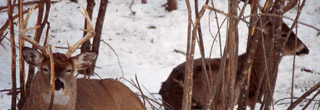Even back in in the early 1960s when I first begin using my primitive platforms and whitetails could not identify me only six feet above the ground, seeing and taking bucks 3-1/2 years of age or older was not a daily occurance. The reason was, it was impossible to predict where they would be located from day to day. Certain events in their lives, like the welling of testosterone in their bloodstrams and does emitting pheromone may occasionally make older antlered bucks more vulnerable to skilled hunting, but by no means 100% vulnerable. The reason is, there are an overwhelming number reasons older bucks are unpredictable. Having the largest of whitetai home ranges and often changing portions they use use during hunting seasons is one. After establishing breeding ranges in mid-October, locations of antlered bucks lesser in their local pecking orders are kept scattered off-range by dominant bucks until November breeding ends. The fact that each doe is only in heat only 24-26 hours and only 10–12% of them, sometimes none, are in heat on any one day during each of the three two-week periods of breeding occurring between early November and the second week in January makes domant bucks, one per square-mile, virtual will-o’-the-wisps. Locations of newly available foods and currently safe feeding areas also often cause difficult to predict changes as well. Falling leaves (loss of screening cover) typically causes deer to switch trails. Intensities of rain or snow, changing air temperatures, snow depths, wind velocities, wind directions, moon phases and hunting by large predators or humans affect locations and hours deer are active. Add to this the fact that older and much experienced bucks are the most wary and elusive of whitetails. After three or more hunting seasons, they recognize every tactic used by hunters today and know exactly how to safely avoid hunters using them. Today a buck like the one photographed at first light in the morning above is very unlikely to be fooled by elaborate stand site preparations. When all else fails, they can quickly become impossible to hunt by abandoning their ranges or becoming nocturnal.
Ironically, if you do things properly, all of the above doesn’t mean beans when it comes to hunting older bucks . All you need to do to become regularly successful is quit stand hunting where you have been stand hunting and begin stand hunting where mature bucks are actually located right now, today, when hunting, which is very likely where they will be located during the next two whitetail feeding periods if not alarmed by you meanwhile. These locations are reestablished midday daily beginning on day-three of a hunting season by using a special wolf-inspired scouting technique that does not ruinously alarm whitetails. Such spots are made evident by very fresh tracks and/or droppings made by an unalarmed (not trotting or bounding) mature buck, most productive if in or adjacent to a feeding area. Such signs are then taken advantage of by switching every day or half=day to new unused stand sites where you will be well hidden within easy shooting distance downwind or crosswind of such deer signs. This will keep you close to matuure bucks every day you hunt until you take a buck—so simple yet so effective.
If you can move a portable tree stand to a new site daily (midday when whitetails are bedded) without tipping off deer in the vicinity, more power to you. Because I’ve never done this well enough to suit me and nearby bucks, I’ve been stand hunt at ground level using a silent-to-carry and use backpacked stool since 1990. I can honestly state, this the most productive way to hunt older bucks today. If you are not already hunting in this manner, sooner or later, you will heartily agree.

